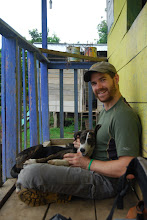---
Lying on my back in a circle of campers, I stare up into the early morning sky, examining some cirrus feathers many miles above, floating imperceptivity across the sky. Keeping a rather constant form, they float like ice crystals through the heavens.

As I observe the depth of this smooth cerulean sky, I notice the subtlest lattice of cirrus, lacing almost invisibly across the sky. In periods measuring tens of minutes they dissolve and reappear - ghosts haunting some ethereal reaches of this world. Whispering of pale blues, the sky fades to a pale white just over the Divide to the west.
As a scarlet sunrise builds on the Divide a family of coyotes let up a chorus of archaic chattering howls. While no one in the circle appears to awake, almost everyone stirs, rolling over, unaware of the subconscious stirring of their mind in response to such a sound. Some simply shake their feet back and forth several times before sleep returns them to stillness. These howls resonate across the land signaling meanings I can only imagine. Perhaps they have killed one of the elk calves that reside in the lower marshy meadows, or perhaps they simple sing the coming of a new day, full of whatever promise and vigor a new day brings to a coyote.
I wonder how such sounds strike the rest of the wildlife around the lake as the familiar uneasy emotions well up inside me at hearing such macabre calls. The veracity I hear in those howls haunt me. Those howls seem to sing out a warning song, celebrating the penetrating sting of their teeth.
As the song falls to one last singularly bold apex, Buteo, an amazing young camper, stirs and notices I am no longer next to him. He rolls around and eventually finds where I am sitting at the picnic table listening. We exchange a knowing smile, and he quickly rolls back over to sleep, not wasting time to revel in any sense of sentimentality of the moment. In one glance he was able to communicate to me that he too felt coyotes song resonate within him.
A scarlet hue sweeps across the highpoints of the land as the sun peeks over the flat horizon to the east. Audubon, several miles away, blushes in the warm embrace of the rising sun. The scarlet curtain sweeps down from atop the hills, across the meadow, highlighting the aspen groves. The hill above the lake fades from a pale gray twilight to a hazy wildfire glow. Every morning I sit attentively, telling myself that if I observe acutely, I will notice this curtain sweep across the marshy alder thickets, over to the slope where I sit in earnest, and I will be draped in the sunrise. Nonetheless, just as I feel the warmth of the direct sunlight upon my feet, the scarlet curtain sunrise dissolves into a lemon-yellow haze and thus, the day has now begun.
Bright sunshine dapples the top of the trees throughout camp, and soon soft morning exhalations whisper through the trees, softly jostling them awake. The top of a Ponderosa shutters with a calm shiver and dampens back to rest like a sleeping dog shifting restlessly in the corner of a room.
Red-Naped Sapsuckers signal back and forth in the calm after sunrise, tapping out a stuttering irregular pattern on a hardened aspen or perhaps a coffee tin left nailed upon a tree on the edge of the meadow for who knows what reason. I hear their young fledglings yelp a whiney call several times back to the parents and then move on to check their crop of bug traps in the ponderosa and lodgepole stands adjoining the meadow. The sticky sap that exudes from the lateral line of holes they excavate effervesces a sweet vanilla-butterscotch smell, not only sweet to humans apparently. Sapsuckers obtain almost the entirety of their nutrition from the attractiveness of this sap to all of the insects that are lured unknowingly to its stickiness. With the sunrise complete, the campers began to stir awake. I put a pot of water on the spider stove, and prepare to cook breakfast.



